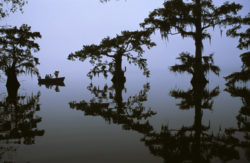Greg Guirard
Greg Guirard's best known photographs capture the stillness of Louisiana's Atchafalaya Basin, its plant and animal residents, and the character and activity of its human population.

Courtesy of Greg Guirard.
“Foggy Morning at Lake Dauterive” (2008) captures the reflection of moss-draped cypress trees in the watery wilderness at dawn’s light.
At the age of two, Greg Guirard moved with his family to the edge of the Atchafalaya Basin in the Acadiana region of South Louisiana. After twenty years away, he returned there, specifically to St Martin Parish, and for the past four decades has devoted his time to photographing the vast, swampy wilderness. Guirard’s photographs capture the stillness of the Atchafalaya landscape, the variety of its plant and animal residents, and the character and activity of its human population, all supported by the photographer’s notion that preserving the basin as a natural feature is fundamental to the existence of the continent.
Guirard was born on May 19, 1937, to James E. Guirard Sr. and Leona Martin Guirard. In 1960 he earned an undergraduate degree in agronomy, followed in 1963 by a master’s degree in English, both from Louisiana State University in Baton Rouge. Guirard never formally studied photography or even read a single book on the subject. His earliest experiments with photography came as a teenager when his grandfather, who had a good-quality camera, let Guirard use it on occasion. In 1957 and 1958, Guirard obtained his own cheap camera and used it to take pictures during summers spent with relatives in Honduras. Those photographs are mostly lost today.
His photographs have been circulated principally through seven books that have been published since 1983. But to characterize Guirard as simply a photographer is to miss the point of his relationship with the Basin, and the zeal he directs toward its health and preservation as a natural feature of Louisiana and the nation’s largest uninterrupted bottomland hardwood forest.
In addition to making photographs, writing, and publishing his books, Guirard has performed many other jobs: teaching English, guiding people through the Basin, operating crew boats, serving as a Cajun speech coach for actors, working in a sawmill, farming, raising cattle, making furniture, salvaging ancient cypress logs from the swamp, and harvesting crawfish. In 1972, Guirard moved with his family to Belize to protest Richard Nixon’s election. In 1977, the Guirards moved to Costa Rica, where he taught school.
After returning to Louisiana in 1978, he worked collecting, cleaning, and selling cypress driftwood. It was during this time he resumed photographing the landscape of the Basin, mostly with a borrowed camera. Guirard admits a preference to making photographs in the early morning or early evening when the light is low and colors tend to be more intense. He shuns manipulation of the image, preferring to let the untouched beauty of his subjects make their own aesthetic declarations.
By 1983, Guirard had enough material to publish his first book of color photography, Seasons of Light. While this book is very focused on natural splendor, Guirard soon began to document not only the physical scene, but the people and cultural traditions of the Basin that he saw fading away with the changing times. His second book, Cajun Families of the Atchafalaya: Their Ways and Words (1989), focuses more on the Basin’s people and the history of their activities. His most recent works look toward sustaining the Basin’s future, merging aspects of the natural environment with human traditions. Additional books by Guirard include Atchafalaya Autumn (1995), and a sequel, Atchafalaya Autumn II (2010), which includes written commentary by Guirard and thirteen other writers. Inherit the Atchafalaya (2007), with commentary by C. Ray Brassieur, contains hundreds of Guirard’s photographs. Two other works (nonfiction and fiction, respectively) round out his works: Psycho Therapy for Cajuns (2006) and The Land of Dead Giants (1991).
Guirard lectures frequently on topics related to the Atchafalaya Basin, yet he considers himself primarily a writer and photographer and by consequence, an advocate. He is active in the Atchafalaya Basinkeeper, an organization that promotes awareness of the Atchafalaya’s unique natural character through monitoring of activities, public programs, and other forms of support. The nongovernmental organization received national recognition in 2011 for the work of its director, Dean A. Wilson, as a guardian of the nation’s water supplies. Guirard’s photographs on the website for the Atchafalaya Basinkeeper present the case for preserving the wilderness. When he was interviewed by Frank De Caro in 1986 for the publication Folklife in Louisiana Photography, Guirard opined that at the present rate of development, the Basin could continue the lifestyle of that era for “another ten or twenty years.” Though he denies that the situation has improved since then, twenty-five years later, thanks in part to Guirard’s work, the Atchafalaya Basin is still holding on.
